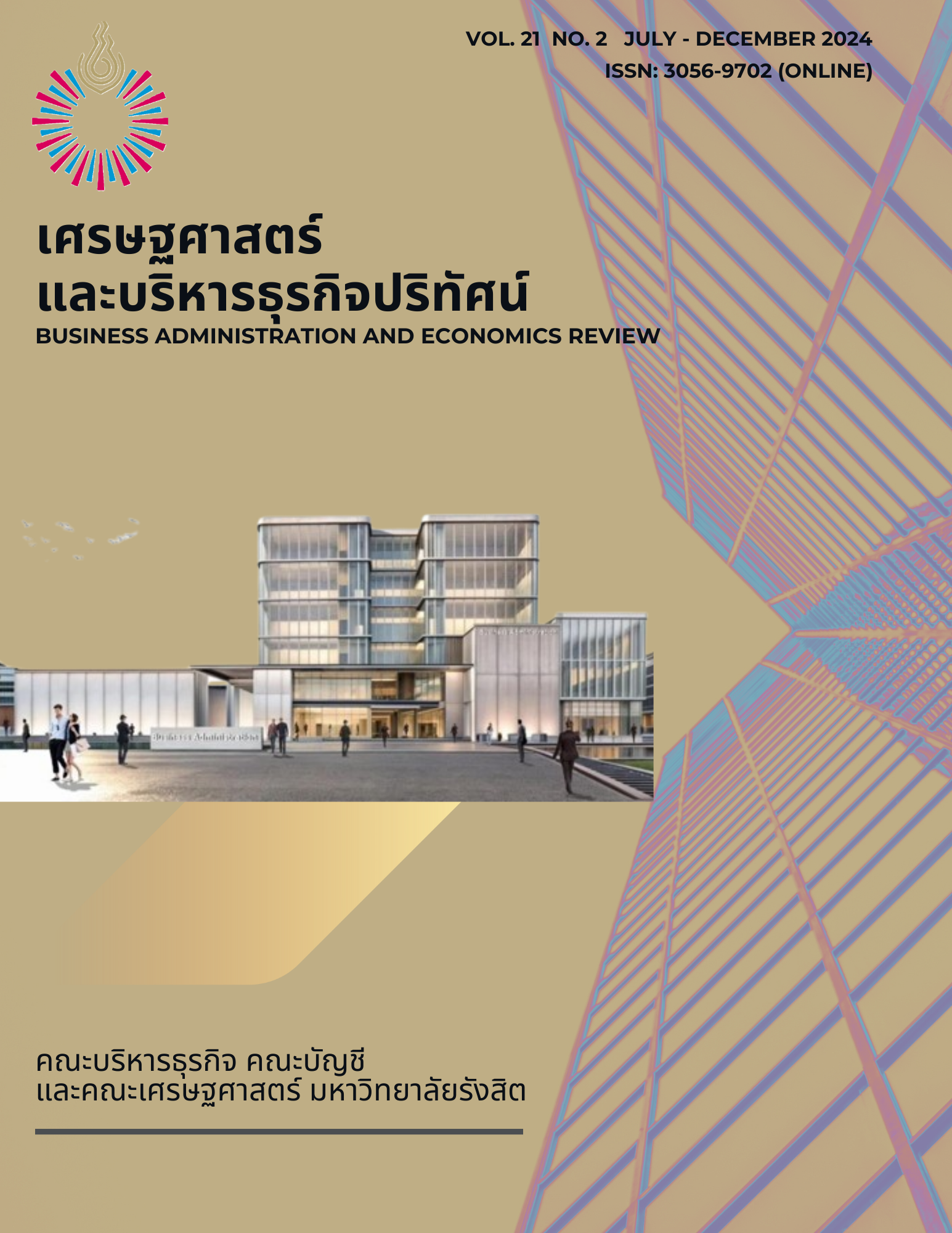Exploring Intelligent Business Systems and Marketing 5.0: Developing a Suitable Preventive Health System Model for the Thai Population Across Diverse Age Cohorts
Keywords:
Preventive Health System, Marketing 5.0, Intelligent Business SystemsAbstract
The objective of this research is to study the health problems of the Thai population across diverse age cohorts and to utilize intelligent business systems and Marketing 5.0 to design and develop a preventive health system tailored to each age group. This qualitative research employs document analysis and in-depth interviews with key informants involved in preventive health systems, intelligent business systems, and Marketing 5.0 at both executive and operational levels in large private hospitals in Chonburi Province. The researcher selected a purposive sample of 20 participants and collected data through semi-structured in-depth interviews, followed by content analysis. The findings reveal that the top five chronic non-communicable diseases among the Thai population are hypertension, diabetes, cardiovascular disease, stroke, and chronic obstructive pulmonary disease. Intelligent business systems and Marketing 5.0 can manage data for analysis and forecasting of preventive health systems. Current marketing strategies must prioritize consumer data to analyze and design preventive health products that are suitable for each age group and individual. Preventive measures before the onset of disease are crucial for all age groups in Thailand. However, the existing preventive health check-up services in hospitals do not cover all diseases comprehensively, indicating a need for further development or improvement. The preventive health system model should allow users to choose the services themselves, ensuring suitability for disease screening for the Thai population across diverse age cohorts.
References
กรมควบคุมโลก. (2566). กรมควบคุมโรค รณรงค์วันเบาหวานโลก 2566 มุ่งเน้นให้ความรู้ประชาชนถึงความเสี่ยงโรคเบาหวาน และหากตรวจพบก่อนจะลดภาวะแทรกซ้อนที่รุนแรงได้. เข้าถึงได้จาก https://ddc.moph.go.th/brc/news.php?news =38403& deptcode=brc&news _views=2606.
กรมประชาสัมพันธ์. (2566, 17 พฤษภาคม). กรมควบคุมโรค แนะประชาชนวัดความดันโลหิตอย่างสม่ำเสมอ “รู้เลข รู้เสี่ยง เลี่ยงโรคไม่ติดต่อ”. เข้าถึงได้จาก https://www.prd.go.th/th/content/category/detail/id/9/iid/182186
กระทรวงสาธารณสุข. (2564). สถิติสุขภาพคนไทยระดับพื้นที่. สถิติสุขภาพคนไทย. เข้าถึงได้จาก https://www.hiso.or.th/thaihealthstat/index.html
กรุงเทพธุรกิจ. (2566, 10 พฤศจิกายน). คุณเสี่ยง "หัวใจอ่อนแอ" หรือไม่ สัญญาณเตือนโรคหัวใจและโรคหลอดเลือดหัวใจ. เข้าถึงได้จาก hthttps://www.bangkokbiznews.com/health/well-being/1098273
ธนรัตน์ บาลทิพย์. (2565). การพัฒนาระบบธุรกิจอัจฉริยะเพื่อสนับสนุนการจัดการโลจิสติกส์ สำหรับธุรกิจขนาดกลางและขนาดย่อม (SMEs) กรณีศึกษาบริษัท XYZ. วารสารสุทธิปริทัศน์, 36(3). 65-82.
บริษัท บิสซิเนส พอร์ทัล จำกัด. (2561). ระบบธุรกิจอัจฉริยะ (Business Intelligence) กับการจัดการ Big Data. MBAMagazine. เข้าถึงได้จาก https://mbamagazine.net/index.php/intelligent/nida-wisdom/item/626-business-intelligence-big-data
ปัทมา เที่ยงสมบุญ และนิเวศ จิระวิชิตชัย. (2561). การพัฒนาระบบธุรกิจอัจฉริยะเพื่อสนับสนุนการพยากรณ์ และการตัดสินใจของผู้บริหาร กรณีศึกษากลุ่มโรงพยาบาล. Veridian E-Journal, Science and Technology Silpakorn University, 5(4), 16-30.
ผู้จัดการออนไลน์. (2567, 19 กุมภาพันธ์). NCDs คร่าชีวิตคนไทย 75% แนวโน้ม "เบาหวาน-ความดัน" เพิ่มปีละ 5%. https://mgronline.com/qol/detail/9670000015146
มหาวิทยาลัยมหิดล. (2564, 1 พฤศจิกายน). ปรับพฤติกรรมสุขภาพ ด้วยเวชศาสตร์วิถีชีวิต. สำนักงานกองทุนสนับสนุนการสร้างเสริมสุขภาพ. เข้าถึงได้จาก https://www.thaihealth.or.th/?p=236894
วัลลภา อันดารา. (2561). การศึกษาภาวะสุขภาพและพฤติกรรมสุขภาพของ ประชาชนในชุมชน บ้านเอื้ออาทรบางเขน (คลองถนน). วารสารแพทย์นาวี, 45(1), 121-138.
ศูนย์ดูแลสุขภาพแบบองค์รวมโรงพยาบาลพระรามเก้า. (2566, 26 มกราคม). 3 เทรนด์การดูแลสุขภาพสไตล์เวลเนสมาแรงในปี 2566. เข้าถึงได้จาก https://w9wellness.com/th/wellness-trends-2023/
ศรีสมบัติ แวงชิน. (2554). การพัฒนาธุรกิจอัจฉริยะด้วยคลังข้อมูล. วารสารนักบริหาร, 31(1), 160-165.
สถานีวิทยุโทรทัศน์แห่งประเทศไทย. (2566, 28 ตุลาคม) สธ. เผย ปี 66 ไทยพบผู้ป่วยโรคหลอด
เลือดสมองกว่า 3.49 แสนราย. เข้าถึงได้จาก https://nbt2hd.prd.go.th/th/content/category/detail/id/2153/iid/227609.
James, K., Elrod, L., John, L., & Fortenberry, Jr . (2020). Advertising in health and medicine: using mass media to communicate with patients. BMC Health Services Research, 20(1). https://doi.org/ 10.1186/s12913-020-05599-3
Kotler, P., Kartajaya, H., & Setiawan, I. (2021). Marketing 5.0: Technology for Humanity. John Willey & Sons
Krueger, R. A. (1998). Moderating Focus Groups. Thousand Oaks, CA: Sage Publications.
Ritchie, J., & Spencer, L. (2002). Qualitative Data Analysis for Applied Policy Research. In A. M. Huberman, & M. B. Miles (Eds.), The Qualitative Researcher’s Companion (pp. 305-329). SAGE Publications, Inc.

Downloads
Published
How to Cite
Issue
Section
License
Copyright (c) 2024 Business Administration and Economics Review

This work is licensed under a Creative Commons Attribution-NonCommercial-NoDerivatives 4.0 International License.
The contents in Business Administration and Economics Review can be used for publication. But do not modify, modify or use it for trade and profit.

